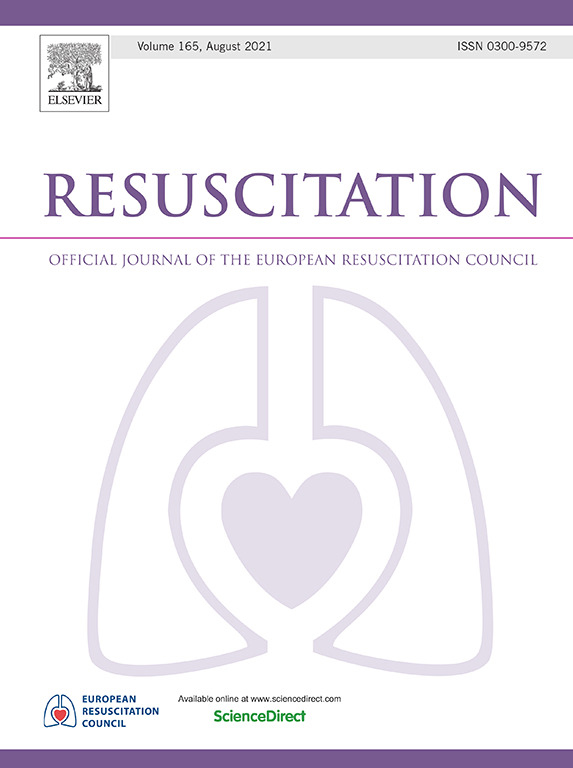停药对心脏骤停后长期神经预后的影响——一项多中心匹配队列研究
IF 4.6
1区 医学
Q1 CRITICAL CARE MEDICINE
引用次数: 0
摘要
目的:评估接受神经预后的昏迷心脏骤停患者停止生命维持治疗(WLST)后自我实现预言的风险。方法:在允许wlst的队列(TTM和TTM2)和不允许wlst的队列(KORHN和ProNeCA)中匹配从院外心脏骤停复苏的成年人的事后多中心研究。根据2021年欧洲复苏委员会/欧洲重症监护医学学会(ERC/ESICM)指南的概述,我们根据倾向评分以1:1的比例匹配患者,评估由于假定的神经预后不良和预测神经预后不良的标准而导致的WLST风险。6个月时比较功能结果。结果:我们纳入了1717例患者,其中497例(29%)由于神经学标准在中位时间为143小时(IQR 108-177)发生WLST。303例(61%)WLST患者回顾性满足≥2个ERC/ESICM标准,预测预后不良。无论是在WLST队列中还是在匹配的对照组中,没有≥2个ERC/ESICM标准的患者在6个月时具有良好的功能结局。1名预后不确定(≤1个ERC/ESICM标准)的患者(0.3%)在WLST队列中有良好的功能结局,而匹配对照组的这一比例为18-26%。在探索性加权估计中,如果没有发生WLST,高达18%的预后不确定的患者可能存活并具有良好的功能结果。结论:在至少有2项ERC/ESICM标准预测预后不良的患者中,WLST自我实现预言的风险可以忽略不计。然而,在预后不确定的患者中,WLST的实践与良好功能结果的可能性较低相关。本文章由计算机程序翻译,如有差异,请以英文原文为准。
Effects of withdrawal of life-sustaining therapy on long-term neurological outcome after cardiac arrest − A multicentre matched cohort study
Purpose
To assess the risk of self-fulfilling prophecy from withdrawal of life-sustaining therapy (WLST) in comatose cardiac arrest patients undergoing neuroprognostication.
Methods
Post-hoc multicentre study matching adults resuscitated from out-of-hospital cardiac arrests, in WLST-permitting cohorts (TTM and TTM2), and non-WLST-permitting cohorts (KORHN and ProNeCA). We matched patients in a 1:1 ratio based on a propensity score, assessing the risk of WLST due to a presumed poor neurological prognosis and criteria predictive of poor neurological outcome, as outlined in the 2021 European Resuscitation Council/European Society of Intensive Care Medicine (ERC/ESICM) guidelines. Functional outcome was compared at six months.
Results
We included 1717 patients, of whom 497 (29 %) had WLST due to neurological criteria at a median of 143 h (IQR 108–177). 303 (61 %) patients with WLST retrospectively fulfilled ≥ 2 ERC/ESICM criteria predictive of poor outcome. No patients with ≥ 2 ERC/ESICM criteria had good functional outcome at six months, neither in the WLST cohort nor among the matched controls. One patient (0.3 %) with an indeterminate prognosis (≤1 ERC/ESICM criteria) had a good functional outcome in the WLST cohort versus 18–26 % of the matched controls. In exploratory weighted estimates, up to 18 % of patients with indeterminate prognosis may have survived with a good functional outcome, if WLST had not occurred.
Conclusion
In patients with at least 2 ERC/ESICM criteria predictive of poor outcome, the risk of self-fulfilling prophecy from WLST was negligible. However, in patients with an indeterminate prognosis, the practice of WLST was associated with a lower likelihood of good functional outcome.
求助全文
通过发布文献求助,成功后即可免费获取论文全文。
去求助
来源期刊

Resuscitation
医学-急救医学
CiteScore
12.00
自引率
18.50%
发文量
556
审稿时长
21 days
期刊介绍:
Resuscitation is a monthly international and interdisciplinary medical journal. The papers published deal with the aetiology, pathophysiology and prevention of cardiac arrest, resuscitation training, clinical resuscitation, and experimental resuscitation research, although papers relating to animal studies will be published only if they are of exceptional interest and related directly to clinical cardiopulmonary resuscitation. Papers relating to trauma are published occasionally but the majority of these concern traumatic cardiac arrest.
 求助内容:
求助内容: 应助结果提醒方式:
应助结果提醒方式:


